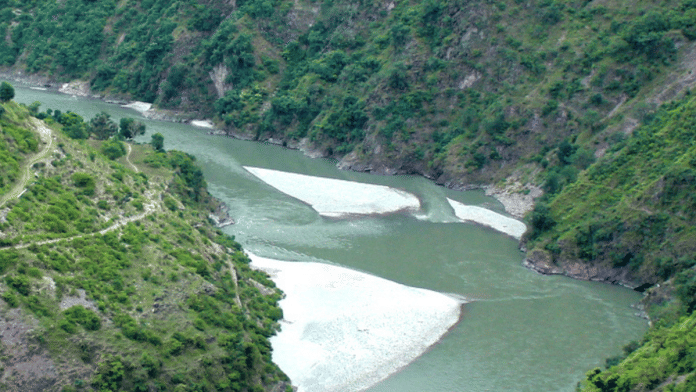Thank you dear subscribers, we are overwhelmed with your response.
Your Turn is a unique section from ThePrint featuring points of view from its subscribers. If you are a subscriber, have a point of view, please send it to us. If not, do subscribe here: https://theprint.in/subscribe/
In the heart of South Asia, where rivers carve out lives and livelihoods, the Indus Waters Treaty (IWT) remains one of the few enduring symbols of India-Pakistan cooperation. Signed in 1960, this World Bank-brokered treaty was lauded as a rare triumph of diplomacy amidst the deepening animosities of partition. Today, however, the Treaty stands at a perilous crossroads -assailed by climate change, strategic suspicion, and nationalist fervour on both sides.
The Treaty divides the six rivers of the Indus basin between the two countries. Pakistan was granted exclusive rights over the western rivers—Indus, Jhelum, and Chenab—while India retained control over the eastern rivers—Ravi, Beas, and Sutlej. The arrangement seemed generous on India’s part, given that about 80% of the water volume went to Pakistan. Yet India saw it as the price for peace and regional stability.
Despite three wars and decades of hostility, the IWT held firm. Disputes were resolved through bilateral negotiations or third-party arbitration. India has developed run-of-the-river projects within its rights, while Pakistan has raised objections, often fearing that India could use dam storage to control water flow during sensitive periods. The Treaty anticipated such disagreements, laying out detailed mechanisms for conflict resolution—from neutral experts to international courts of arbitration.
But the times have changed. What was once a model of hydro-diplomacy is now showing deep cracks. For India, the IWT has increasingly come to feel like a straitjacket—one that restrains its strategic options even as Pakistan provides safe havens for anti-India terror outfits. Following the 2016 Uri attacks, Prime Minister Modi declared, “Blood and water cannot flow together,” signalling a shift in India’s strategic calculus.
In 2023, India formally notified Pakistan of its intent to modify the Treaty. The government argued that the current dispute resolution mechanism—requiring parallel arbitration and neutral expert procedures—was dysfunctional and in need of reform. Pakistan, however, sees these moves as attempts to dilute its water security and increase India’s leverage.
Meanwhile, both countries are under mounting pressure from the looming threat of climate change. Glacial melt in the Himalayas, erratic monsoons, and intensifying droughts have added volatility to river flows. Population growth and agricultural dependence in both nations make water not just a political resource, but an existential one. The Treaty, drafted in an era when environmental foresight was limited, makes no provisions for ecological sustainability, inter-state water disputes within India or Pakistan, or the rights of river-dependent communities.
There’s also a geopolitical dimension that cannot be ignored. The involvement of external powers—be it the World Bank’s role in arbitration, or Western experts pushing techno-legal interpretations—has drawn criticism. Some in India argue that this multilateral footprint infringes on national sovereignty, while others in Pakistan suspect international bias. Rather than open the door for Western scrutiny, it might be time for the region to reclaim its hydrological future through a revived SAARC platform or a new South Asian water dialogue framework—one that acknowledges contemporary realities and fosters mutual trust.
At a time when both countries have nuclear capabilities, unresolved water tensions carry disproportionately high risks. Water can either be a weapon or a bridge. It is in the interest of both countries to choose the latter. Unilateral withdrawal from the Treaty is legally complex and politically hazardous. But so is inaction. What is required is neither abandonment nor blind preservation, but a comprehensive rethinking of the Treaty that considers present-day hydrological, environmental, and political realities.
There are lessons to be drawn from other transboundary river systems—from the Mekong to the Nile—where cooperative mechanisms, though imperfect, evolve with time. India and Pakistan, with decades of IWT experience, could lead the way in reshaping water diplomacy in a fractured world.
For India, such a reimagination also involves reconciling internal contradictions. River waters in Jammu & Kashmir are a sensitive issue. The abrogation of Article 370 has added new layers of complexity, particularly with Ladakh now a Union Territory and the growing assertion of ecological rights by hill communities. Similarly, Pakistan faces its own internal water conflicts—between provinces, farmers, and cities. In both nations, the first step toward transboundary justice may be domestic water equity.
Ultimately, water is more than a resource—it is a shared civilizational inheritance. The rivers of the Indus basin have flowed long before borders were drawn, and they will (if managed well) continue long after our current political architectures fade. To protect them, and the millions who depend on them, the IWT must evolve—or risk becoming irrelevant.
Let this not be a eulogy for a Treaty that once defied the odds, but a call to refresh it for a generation that has inherited the consequences of conflict—and still dreams of peace.
These pieces are being published as they have been received – they have not been edited/fact-checked by ThePrint.


